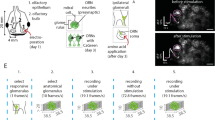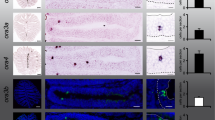Abstract
ODORANT signal transduction occurs in the specialized cilia of the olfactory sensory neurons. Considerable biochemical evidence now indicates that this process could be mediated by a G protein-coupled cascade using cyclic AMP as an intracellular second messenger1. A stimulatory G protein α subunit is expressed at high levels in olfactory neurons and is specifically enriched in the cilia2, as is a novel form of adenylyl cyclase3. This implies that the olfactory transduction cascade might involve unique molecular components. Electrophysiological studies have identified a cyclic nucleotide-activated ion channel in olfactory cilia4. These observa-tions provide evidence for a model in which odorants increase intracellular cAMP concentration, which in turn activates this channel and depolarizes the sensory neuron. An analogous cascade regulating a cGMP-gated channel mediates visual transduction in photoreceptor cells (see refs 5,6 for review). The formal similarities between olfactory and visual transduction suggest that the two systems might use homologous channels. Here we report the molecular cloning, functional expression and characterization of a channel that is likely to mediate olfactory transduction.
This is a preview of subscription content, access via your institution
Access options
Subscribe to this journal
Receive 51 print issues and online access
$199.00 per year
only $3.90 per issue
Buy this article
- Purchase on Springer Link
- Instant access to full article PDF
Prices may be subject to local taxes which are calculated during checkout
Similar content being viewed by others
References
Pace, U., Hanski, E., Salomon, Y. & Lancet, D. Nature 316, 255–258 (1985).
Jones, D. T. & Reed, R. R. Science 244, 730–736 (1989).
Pfeuffer, E., Mollner, S., Lancet, D. & Pfeuffer, T. J. biol. Chem. 264, 18803–18807 (1989).
Nakamura, T. & Gold, G. H. Nature 325, 442–444 (1987).
Stryer, L. A. Rev. Neurosci. 9, 87–119 (1986).
Yau, K.-W. & Baylor, D. A. A. Rev. Neurosci. 12, 289–327 (1989).
Kaupp, U. B. et al. Nature 342, 762–766 (1989).
Jones, D. T., Barbosa, E. & Reed, R. R. Cold Spring Harb. Symp. quant Biol. 53, 349–353 (1988).
Gorman, C. M., Gies, D. R. & McCray, G. DNA and Protein Engineering Techniques 2, 3–9 (1990).
Pritchett, D. B. et al. Science 242, 1306–1308 (1988).
Hamill, O. P., Marty, A., Neher, E., Sakmann, B. & Sigworth, F. J. Pflügers Arch. 391, 85–100 (1981).
Tanaka, J. C., Eccleston, J. F. & Furman, R. E. Biochemistry 28, 2776–2784 (1989).
Dhallan, R. S., Haynes, L. W. & Yau, K.-W. Biophys. J. 57, 367a (1990).
Koch, K.-W. & Kaupp, U. B. J. biol. Chem. 260, 6788–6800 (1985).
Karpen, J. W., Zimmerman, A. L., Stryer, L. & Baylor, D. A. Proc. natn. Acad. Sci. U.S.A. 85, 1287–1291 (1988).
Haynes, L. W. & Yau, K.-W. Biophys. J. 57, 366a (1990).
Hodgkin, A. L. & Katz, B. J. Physiol., Lond. 108, 37–77 (1949).
Kurahashi, T. J. Physiol., Lond. 419, 177–192 (1989).
Firestein, S. & Werblin, F. Science 244, 79–81 (1989).
Kozak, M. Nucleic Acids Res. 12, 857–872 (1984).
Kyte, J. & Doolittle, R. F. J. Molec. Biol. 157, 105–132 (1982).
Nathans, J. & Hogness, D. Cell 34, 807–814 (1983).
Jones, D. T. & Reed, R. R. J. biol. Chem. 262, 14241–14249 (1987).
Nakatani, K. & Yau, K.-W. J. Physiol., Lond. 395, 695–729 (1988).
Author information
Authors and Affiliations
Rights and permissions
About this article
Cite this article
Dhallan, R., Yau, KW., Schrader, K. et al. Primary structure and functional expression of a cyclic nucleotide-activated channel from olfactory neurons. Nature 347, 184–187 (1990). https://doi.org/10.1038/347184a0
Received:
Accepted:
Issue Date:
DOI: https://doi.org/10.1038/347184a0
This article is cited by
-
Conformational trajectory of allosteric gating of the human cone photoreceptor cyclic nucleotide-gated channel
Nature Communications (2023)
-
Structure of the human cone photoreceptor cyclic nucleotide-gated channel
Nature Structural & Molecular Biology (2022)
-
Odor coding in the mammalian olfactory epithelium
Cell and Tissue Research (2021)
-
Phospho-substrate profiling of Epac-dependent protein kinase C activity
Molecular and Cellular Biochemistry (2019)
-
Structure of a eukaryotic cyclic-nucleotide-gated channel
Nature (2017)
Comments
By submitting a comment you agree to abide by our Terms and Community Guidelines. If you find something abusive or that does not comply with our terms or guidelines please flag it as inappropriate.



